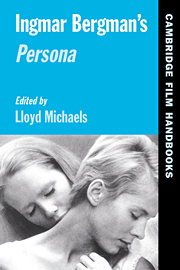Book contents
- Frontmatter
- Contents
- Acknowledgments
- List of Contributors
- Bergman and the Necessary Illusion
- 1 Bergman's Persona through a Native Mindscape
- 2 Persona and the 1960s Art Cinema
- 3 Bergman's Persona
- 4 Scenes from the Class Struggle in Sweden
- 5 Persona and the Seduction of Performance
- 6 Feminist Theory and the Performance of Lesbian Desire in Persona
- Filmography
- Reviews of Persona
- Select Bibliography
- Photographic Credits
- Index
6 - Feminist Theory and the Performance of Lesbian Desire in Persona
Published online by Cambridge University Press: 29 January 2010
- Frontmatter
- Contents
- Acknowledgments
- List of Contributors
- Bergman and the Necessary Illusion
- 1 Bergman's Persona through a Native Mindscape
- 2 Persona and the 1960s Art Cinema
- 3 Bergman's Persona
- 4 Scenes from the Class Struggle in Sweden
- 5 Persona and the Seduction of Performance
- 6 Feminist Theory and the Performance of Lesbian Desire in Persona
- Filmography
- Reviews of Persona
- Select Bibliography
- Photographic Credits
- Index
Summary
Lesbian feminist theory, and, in particular, performance theory that has emerged in the past decade have particular relevance in a re-vision of Persona, a film that is centrally concerned with the performance of lesbian desire. The marked shift toward an emphasis on the production of meaning via spectatorship rather than authorship has facilitated the new queer performative theories. Briefly, performative theory holds that gestures, role playing, and external manifestations of one's physical presence reveal an inner existence, in which the self is “performed” as an act of social expression. Feminist film theorists have moved away from the spectatorial model posited in Laura Mulvey's early writing. Mulvey, although she later modified the position, is famous for her essay, “Visual Pleasure in the Narrative Cinema.”. Here she established the notion that all cinematic texts address an overdetermined model of spectator, the white male heterosexual. A veritable avalanche of film criticism depended on Mulvey's model, and even when she redefined and revisited this model to begin to develop theories of other spectators, it would be many years before film critics embraced a model of spectatorship that involved queer and female audiences and the queer female psychological theories of spectatorship now seen in the work of writers such as Judith Mayne, Teresa de Lauretis, and Chris Straayer. The remarkable shift to spectator theory opened the space for reading films such as Persona against the grain of so-called dominant heterosexual male spectatorship and authorship.
- Type
- Chapter
- Information
- Ingmar Bergman's Persona , pp. 130 - 146Publisher: Cambridge University PressPrint publication year: 1999

